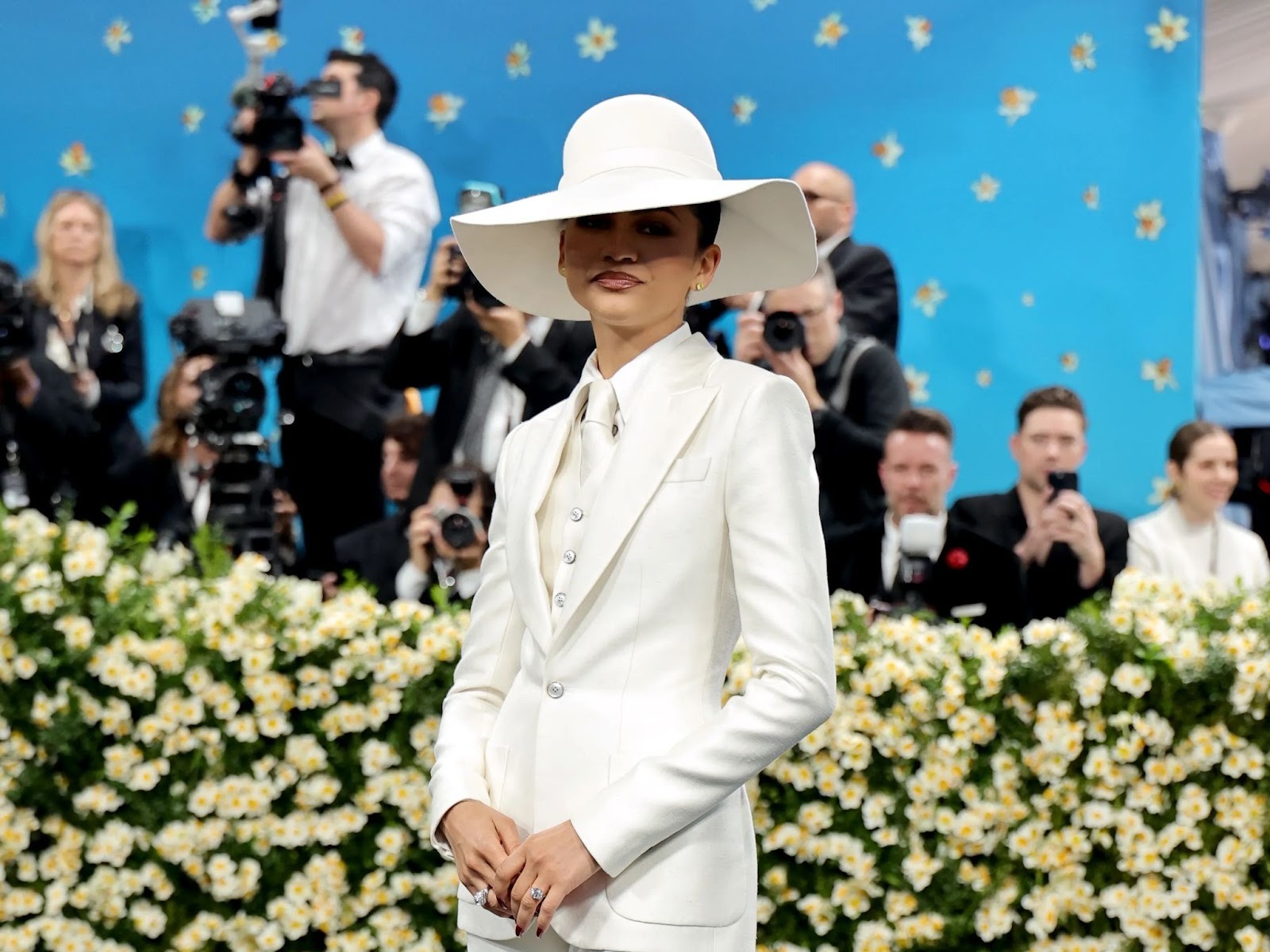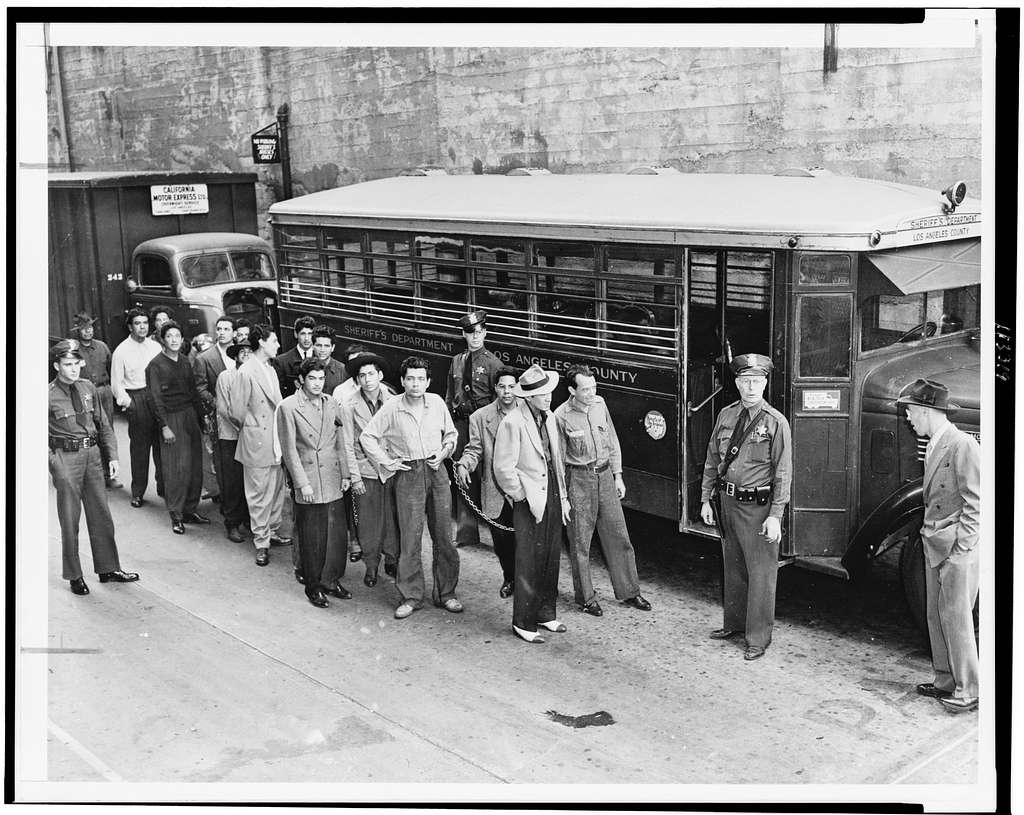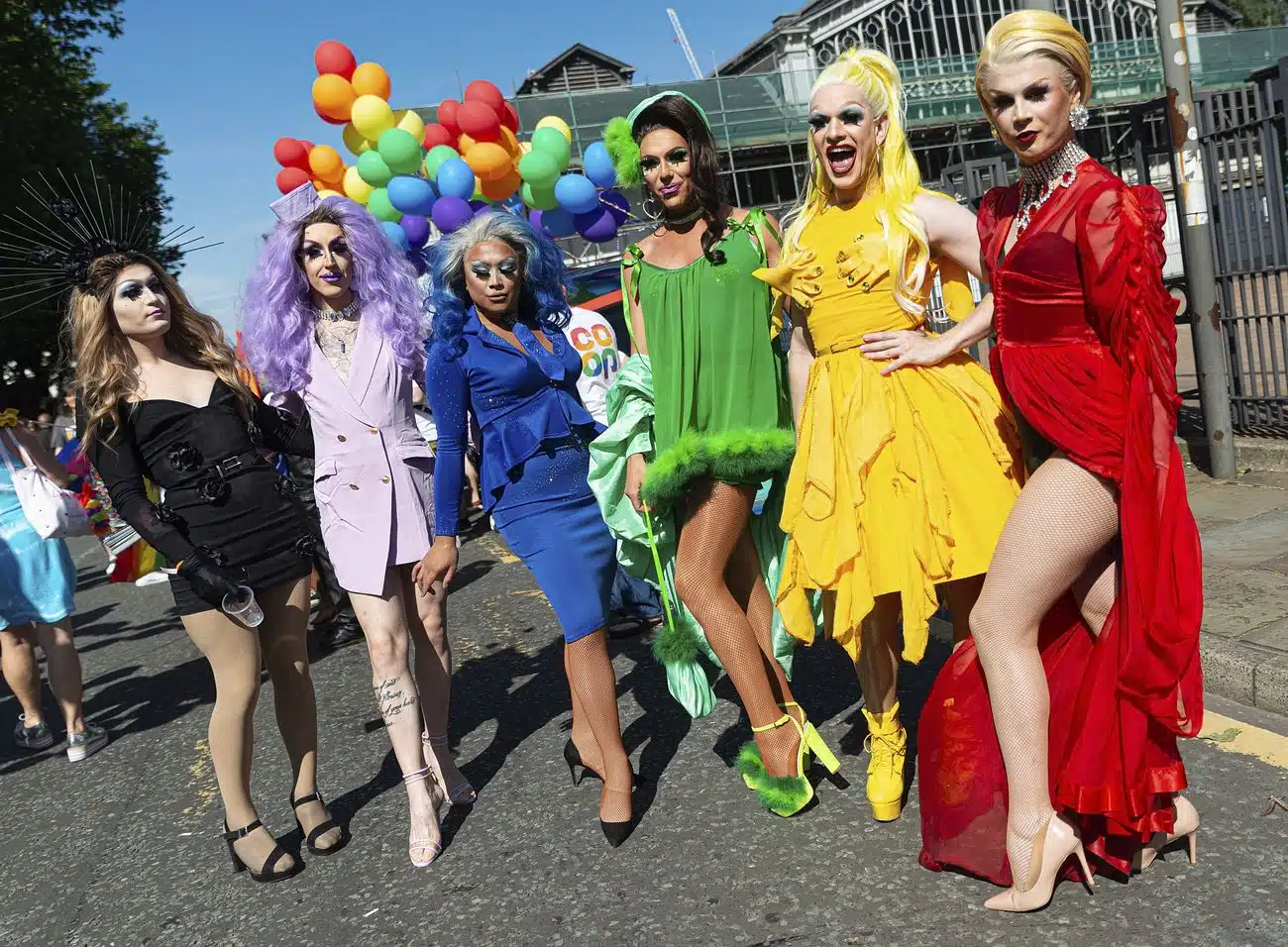Source: Picryl.
The Invention of the Zoot Suit
“Zoot” is a verb that refers to something done or worn in an exaggerated style. As you can imagine, when applied to a suit, the content evoked is a larger-than-life piece of clothing. The suit itself created a tall and slender silhouette, had high collars, and pants that ballooned from the hips but were cuffed around the ankles. The shoulder pads created a very broad shouldered look, which was emphasized but the tight, high waist of the pants. The fit itself wasn’t the only interesting aspect of the suits, however. They came in a variety of fun colors including lime green, canary yellow, plaid stripes, houndstooth prints, and more.
Young, African-American men in Harlem were the first to don the suits, but they quickly became popular all across urban American and among Hispanic-Americans as well. Wearing the suit wasn’t just about how you looked. It was about how you carried yourself. African-American men usually paired the suit with slicked-back hair or a black felt hat, and Hispanic-American men wore a signature ducktail hairstyle. Suit-wearers walked with a strut and spoke in “argot,” a type of slang vocabulary unique to their communities (this differed between African-American and Hispanic-American men).
Historians aren’t entirely sure who the first person to wear a zoot suit was, but what we do know is that it spread through jazz clubs in Harlem, eventually moving to Upper Manhattan, and later, to Los Angeles. Its appeal was largely an aesthetic of “coolness,” but it also had other benefits. It made one feel composed as an individual, secure in their power, and it brought social stability as a group. Wearers presented status among their peers, and a threat to the dominant culture.
Examples from History
- Famous jazz musicians. Many jazz musicians of the time popularized the zoot suit. This includes Cab Calloway, Count Basie, Dizzy Gillespie, Duke Ellington, and more.
- Activists wore them. Two of note are Malcolm X and Cesar Chavez.
- The Invisible Man by Ralph Ellis. In the 1952 novel, the protagonist encounters a group of men dressed in zoot suits and comments that he’d “never seen their like before.”
There’s even a 1979 musical by Louis Valdez called Zoot Suits and a 1981 film by the same name.

Source: Vogue Arabia.
Examples from Popular Culture
- 2025 Met Gala. The theme of the most recent Met Gala was “Tailored for You,” which highlighted the Costume Institute’s “Superfine: Tailoring Black Style” theme. In particular, the Met focused on Black Dandyism, or the way Black people use style as a means of reclamation and protest. Wearers of the Hispanic zoot suit included Colombian singer Maluma and American designer Willy Chavarria. Dapper Dan highlighted his Ghanaian heritage through his zoot suit, and Zendaya went with a sharp, all-white suit for hers.
The Cultural Significance of Zoot Suits
In some ways, because both African-American and Hispanic-American men shared this fashion style, it served as a kind of solidarity between the communities, despite them largely being separated by coast. In their own communities, zoot suits even established solidarity between genders. For example, in the Hispanic community in Los Angeles, zoot suit-wearers were called pachucos, and their female counter-parts were called pachucas. Pachucas, who aren’t given as much attention in history, were a group of female zoot suit-wearers who donned huge blazers over fishnets and kitten heels. They can be found in Tony Montes-Michie’s solo show, Dishwater Holds No Images, in which he revives old magazine ads from the 1970s to make their wearers look how they would have in real life: Black and brown.
In the 1940s, wearing a zoot suit became a form of resistance. It was a statement of refusal to conform to both white Western culture, and the older generations in one’s own culture. Because of its popularity in primarily Black and Hispanic neighborhoods, it became associated with gang activity by the white masses, regardless of any actual correlation between the two. Similarly, in the context of World War II, the suits came across as unpatriotic. The garments required a lot of fabric to produce, so they defied war-time clothing rations issued by the War Production Board.
For this reason, they were prohibited in 1942 until the end of the war. In fact, the reason the Mexican-American population grew so significantly was because the U.S. had a deal with Mexico to send over temporary workers to help essential industries remain functional during wartime. Many Americans saw these men demanding to be seen and resented them for it.

Source: LA Times.
The Zoot Suit Riots
The event that kicked off the zoot suit riots was the murder of José Díaz in 1942, also known as the Sleepy Lagoon Murder. Días, only 22 years old at the time, was brutally murdered at a party only one day before he left to serve his country. This incident only fueled the fear in the minds of the white people living in Los Angeles. Governor Olson ordered the Los Angeles police to arrest more than 600 Mexican American youth. More than 20 indictments were issued in Díaz’s death, and one was even sentenced to life in prison. Many of these indictments were reversed on appeal the following year.
It wasn’t just the government that took action, however. On May 31st, a fight broke out between U.S Navy servicemen on leave and a group of Mexican American teenagers wearing zoot suits. A soldier was injured in the fight. As retaliation, on June 3rd, 1943 in East Los Angeles, 50 white sailors marched through the streets with clubs and crude weapons to attack anyone wearing a zoot suit. They referred to one of these weapons as a “zootbeater,” or a two-by-four with nails.
The retaliation included beating the suit-wearers, removing their clothes, and burning them or urinating on them. The riots continued for days, finally ending on June 7th when military officials removed servicemen from Los Angeles and ordered military police to arrest any “disorderly” individuals on June 8. This was a stark charge from the riots themselves, during which the police more or less stood by, and arrested the suit-wearers if they were to arrest anyone.
After that, the riots were officially over. Other than José Díaz, no one else was killed, but many were injured, and the amount of Mexican-Americans in police custody greatly outnumbered the serviceworkers.
Now, the suits are associated with political protest and activism.
The Legacy of Zoot Suits
Although zoot suits as they were recognized in the 1940s fell out of fashion only ten years later, there’s still so much we can learn from them. In 2025, clothing is still heavily policed in the United States. Consider the following:
- Sexist dress codes. In many schools, different standards are held for men compared to women. If young boys get “distracted” in school, it is considered the fault of the young girls for revealing their shoulders or having hair that’s too long.
- Hijabs. It’s not uncommon for people who wear hijabs or other religious coverings to experience hate crimes in the United States. The same goes for niqab, turbans, and the Jewish kippah.
- Black women’s hair. For years, black people, and black women in particular, have been fighting to be seen as professional in the workplace. They face an ideal that their hair must be as “white” as possible, limiting both creative expression and overall comfort.
- Tattoos. Though many people get tattoos for fun, they’re deeply symbolic in certain ethnic groups. The Maori people, the Osage people, the Inuit people, and Okinawans are just a few who adorn themselves with meaningful tattoos. However, tattoos are often deemed unprofessional and therefore not allowed in the workplace.
The ability to express oneself isn’t a privilege, it’s a right. That’s why it’s important to take action when you see your or someone you know’s rights being violated. Similarly, you should express yourself and your own beliefs with fashion. Take for example college students wearing keffiyahs to class, or athletes donning pink in October to show their support for the fight against breast cancer.
Summing up the Influence of Zoot Suits
Over 80 years ago, a bold new look made its way into Black and Hispanic American fashion. Zoot suits were a bold disruption of the status quo, and due to that disruption and the spread of stereotypes, wearers of the suits were heavily punished. Now, we can take examples from political activists who wore the suits (such as Malcom X and Cesar Chavez) to use our own fashion to make a statement.






.png)
